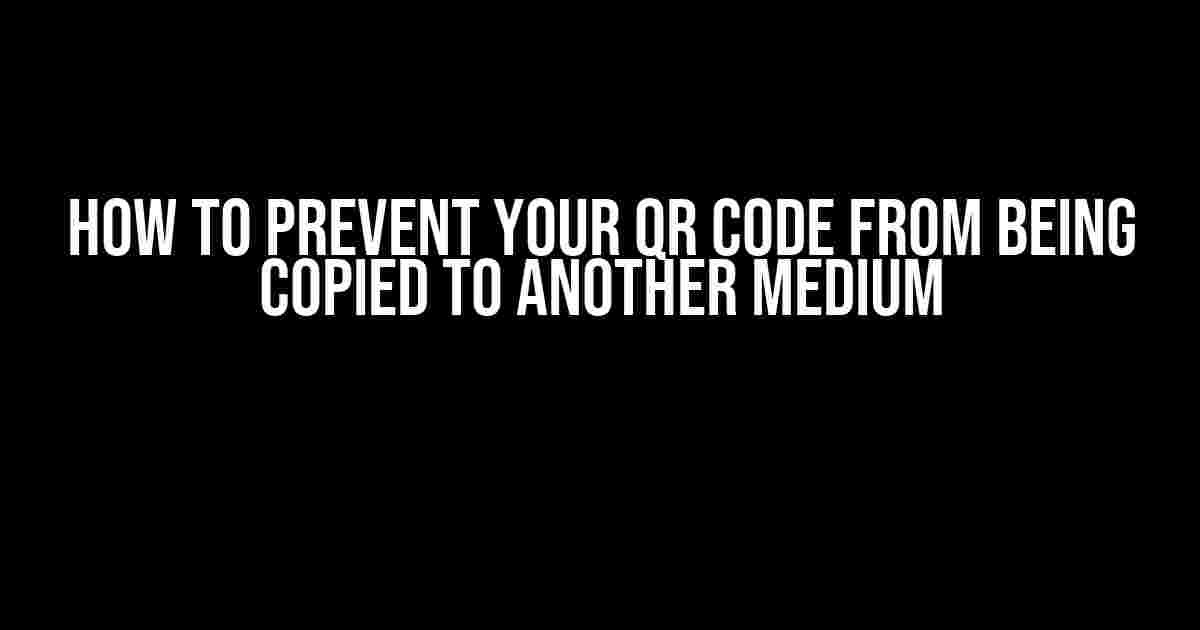Are you worried that your QR code might be copied to another medium, compromising its security and integrity? You’re not alone! With the increasing use of QR codes in various industries, it’s essential to take measures to prevent unauthorized duplication. In this article, we’ll guide you through the steps to prevent your QR code from being copied to another medium, ensuring your data remains safe and secure.
Why You Need to Protect Your QR Code
QR codes have become an indispensable tool for businesses, marketers, and individuals alike. They provide a convenient way to store and share information, track inventory, and facilitate payments. However, this convenience comes with a risk – the potential for your QR code to be copied and used maliciously.
Imagine a competitor copying your QR code and using it to steal your customers or manipulate your data. Or, picture a scammer duplicating your QR code to phish or spam unsuspecting victims. The consequences can be devastating, leading to financial losses, damage to your reputation, and compromised data security.
Understanding How QR Codes Can Be Copied
Before we dive into the prevention strategies, it’s essential to understand how QR codes can be copied:
- Photocopying or scanning: Someone can simply photocopy or scan your QR code, reproducing it on paper, cardboard, or any other medium.
- Screen capturing: A person can take a screenshot of your QR code displayed on a screen, such as a phone, tablet, or computer.
- Image editing: A QR code can be edited using image editing software to remove or modify its contents.
- QR code reader apps: Some QR code reader apps can decode and store the contents of your QR code, making it vulnerable to unauthorized access.
Methods to Prevent QR Code Duplication
Now that we’ve covered the potential threats, let’s explore the methods to prevent your QR code from being copied to another medium:
1. Use a Secure QR Code Generator
Choose a reputable QR code generator that offers advanced security features, such as:
- Encrypted QR codes: Some generators encrypt the QR code data, making it difficult for unauthorized users to access the contents.
- Password protection: Set a password to protect your QR code, ensuring only authorized users can access the data.
- Dynamic QR codes: Use dynamic QR codes that can be updated or revoked remotely, allowing you to maintain control over the data.
Example of an encrypted QR code:
https://example.com/encryptedqr?data= encrypted_data
2. Add a Watermark or Overlay
Embed a watermark or overlay on your QR code to make it difficult for others to copy or reproduce:
Example of a watermarked QR code:
This can include:
- Translucent overlays: Add a semi-transparent layer over the QR code, making it challenging to scan or reproduce.
- Branding elements: Incorporate your logo, colors, or typography to make the QR code unique and difficult to duplicate.
3. Implement Digital Rights Management (DRM)
Use DRM solutions to restrict access to your QR code content, ensuring only authorized users can view or interact with the data:
Example of a DRM-protected QR code:
https://example.com/drm_qr?data=protected_data
This can include:
- Geo-restrictions: Limit access to your QR code based on geographical location.
- Time-based restrictions: Set expiration dates or time limits for QR code access.
- Device-based restrictions: Restrict access to specific devices or platforms.
4. Utilize QR Code Readers with Security Features
Choose QR code reader apps or software that offer advanced security features, such as:
- Authentication: Require users to authenticate before accessing the QR code data.
- Data encryption: Encrypt the QR code data during transmission or storage.
- Access controls: Implement role-based access controls to restrict access to the QR code data.
Example of a secure QR code reader:
Best Practices for QR Code Security
In addition to the methods mentioned above, follow these best practices to ensure the security of your QR code:
- Use a unique QR code for each application: Avoid using the same QR code for multiple purposes to minimize the risk of unauthorized access.
- Keep your QR code up-to-date: Regularly update your QR code to ensure it remains secure and functional.
- Monitor QR code usage: Track QR code scans and interactions to detect potential security breaches.
- Educate users: Inform users about the importance of QR code security and how to handle QR codes safely.
Conclusion
Preventing your QR code from being copied to another medium requires a combination of advanced security features, careful planning, and best practices. By following the methods and guidelines outlined in this article, you can ensure the integrity and security of your QR code data.
Remember, QR code security is an ongoing process that requires vigilance and attention to detail. Stay ahead of potential threats by staying informed about the latest security measures and trends.
| QR Code Security Tips | Benefits |
|---|---|
| Use a secure QR code generator | Protects against unauthorized access |
| Add a watermark or overlay | Makes QR code difficult to copy or reproduce |
| Implement Digital Rights Management (DRM) | Restricts access to QR code content |
| Utilize QR code readers with security features | Enhances data security and access controls |
By taking these measures, you can confidence that your QR code remains secure and protected from unauthorized duplication.
Do you have any questions or concerns about QR code security? Share your thoughts in the comments below!
Here are 5 questions and answers about preventing QR codes from being copied to another medium:
Frequently Asked Question
Hey there! Got questions about keeping your QR codes secure? We’ve got you covered!
Is it possible to completely prevent someone from copying my QR code?
Sorry to be the bearer of bad news, but the short answer is no. A determined individual can always find a way to copy your QR code, whether it’s by taking a photo or using a QR code reader app. However, there are steps you can take to make it much harder for them to do so.
How can I make it harder for people to copy my QR code?
One way to make it harder is to use a QR code with a high error correction level. This means that even if someone tries to take a low-quality photo of the QR code, the error correction will help to ensure that the code can still be read. You can also use a QR code with a unique identifier or digital signature to make it more difficult to replicate.
Can I use a watermark or overlay to protect my QR code?
Yes, you can use a watermark or overlay to make it more difficult for people to copy your QR code. A watermark can be a semi-transparent image or text that is superimposed over the QR code, making it harder to reproduce. An overlay can be a transparent image or animation that is displayed on top of the QR code, making it harder to read or copy.
Are there any other ways to keep my QR code secure?
Yes, there are several other ways to keep your QR code secure. You can use encryption to scramble the data in the QR code, making it unreadable to anyone who doesn’t have the decryption key. You can also use a QR code that requires a password or authentication to access the underlying data. Finally, you can use a QR code generator that offers built-in security features, such as secure checksums or digital signatures.
What if someone still manages to copy my QR code?
If someone still manages to copy your QR code, there are steps you can take to mitigate the damage. You can set up a system to detect and flag suspicious activity, such as multiple scans from the same location or device. You can also use analytics tools to track the usage of your QR code and identify any potential security breaches.


